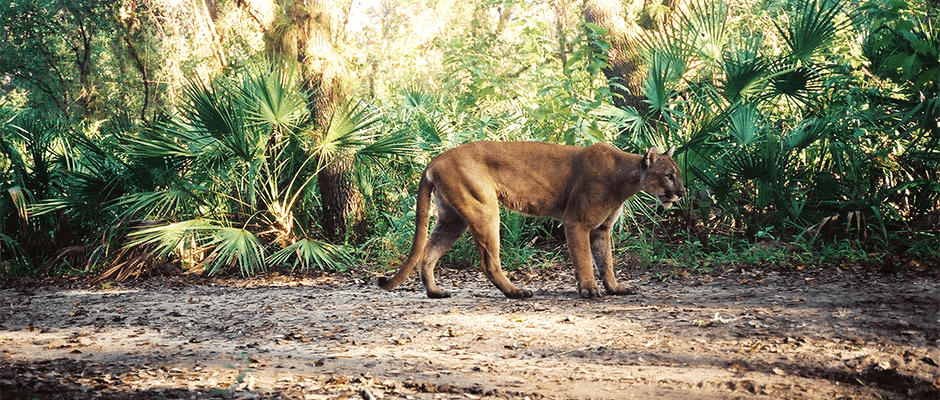Share this article
Populations of three endangered mammals increased in 2016
New population estimates for 2016 have revealed net population increases for the Florida panther, Florida manatee, and Mexican gray wolf since 2015. For each of these three endangered species, this signifies a welcome sign of success for ongoing conservation efforts. Although mortality statistics were also high in 2016, the reports of positive population growth are encouraging to the wildlife professionals responsible for managing the species.
Florida panther (Puma concolor coryi)
On Feb. 22, the USFWS issued a press release announcing the newest Florida panther population estimate as determined by the USFWS and the Florida Fish and Wildlife Conservation Commission (FWC). The updated estimate stands at 120 to 230 adult and subadult Florida panthers in the species’ breeding range south of the Caloosahatchee River—a relatively significant increase from the previous estimate of 100 to 180 panthers.
The largest threat facing the Florida panther is habitat loss, fragmentation, and degradation due to human development combined with mortality from collisions with vehicles. In 2016, 42 panthers were killed on Florida roadways—matching the 2015 record. This makes the increased population estimate especially welcome news.
Kipp Frohlich, the FWC’s Deputy Director for the Division of Habitat and Species Conservation, said of the update, “This latest Florida panther population estimate is good news, an indication that conservation efforts are on track in helping recover this endangered animal.” He noted that the population was estimated at only 20 to 30 panthers in the 1970s and 1980s.
The USFWS listed the Florida panther as an endangered subspecies of the cougar in 1967. Since then, the USFWS and the FWC have worked together and with other federal agencies and private partners to protect and recover the only known breeding population of cougar in the eastern United States. The USFWS finalized its most recent Florida Panther Recovery Plan in 2008.
The FWC publishes its Florida panther research and updates online at the Florida Panther Net.
Florida manatee (Trichechus manatus latirostris)
On Feb. 20, the FWC issued a news release announcing the results of its most recent synoptic survey of the Florida manatee. The preliminary aerial count found 6,620 manatees in Florida waters—the third straight annual count of over 6,000 manatees.
Gil McRae, a FWC biologist and the head of the FWC’s Fish and Wildlife Research Institute, stated in the news release, “Successful conservation of manatees is a product of the commitment made by many different organizations over multiple decades. The relatively high counts we have seen for the past three years underscore the importance of warm water habitat to manatees in Florida. The FWC will continue to work diligently with our many partners to ensure the long-term viability of these habitats and the well-being of the manatee population.”
According to the FWC’s 2016 Preliminary Manatee Mortality Table, 520 manatees were found dead last year, an increase from 405 manatees in 2015 and 371 in 2014. Of the 520 manatees known to have died in 2016, 104 died from collisions with watercraft.
The Florida manatee is considered an endangered subspecies of the West Indian manatee, whose range spans coastal waters of the southeastern U.S., eastern Mexico, the Caribbean islands, and northern South America. In Florida, its primary threats are the loss of warm water habitat, fatal boat strikes, and harmful algal blooms.
On Jan. 8, 2016, the USFWS proposed to reclassify the Florida manatee from endangered to threatened, citing significant recovery efforts and a better understanding of manatee population demographics. The Florida manatee first received federal protections as an endangered species in 1967 and has also been protected by the Marine Mammal Protection Act since 1972.
Mexican gray wolf (Canis lupus baileyi)
On Feb. 17, the USFWS issued a news release reporting that in its annual year-end population survey, the Mexican wolf Interagency Field Team (IFT) documented at least 113 endangered Mexican gray wolves inhabiting the Mexican Wolf Experimental Population Area in Arizona and New Mexico. That number is up from a total of 97 wolves counted in the experimental population in 2015. The counts were obtained through on-the-ground and aerial survey methods conducted between November 2016 and February 2017.
USFWS Southwest Regional Director Benjamin Tuggle remarked, “We are encouraged by these numbers, but these 2016 results demonstrate we are still not out of the woods with this experimental population and its anticipated contribution to Mexican wolf recovery.”
Mexican gray wolf deaths also hit a record high in 2016—14 wolves were confirmed dead, more than during any other year since the USFWS established the nonessential experimental population in 1998. A number of these deaths are still under investigation as illegal shootings.
The USFWS established the experimental Mexican gray wolf population as part of the the collaborative Mexican Wolf Recovery Program following years of captive breeding and reintroduction efforts since the endangered subspecies of the gray wolf was listed under the ESA in 1976. Mexican gray wolves were extirpated from the Southwestern U.S. primarily through hunting and predator control campaigns during the mid-1900s.
On Feb. 14, Sen. Jeff Flake (R-AZ) introduced S. 368, the Mexican Gray Wolf Recovery Plan Act, which would require the USFWS to issue a “scientifically valid and State-supported” recovery plan including input from ranchers and other local stakeholders. It would also establish a process for transferring wolf management authority to state wildlife agencies. Some ranchers have vocally opposed Mexican gray wolf reintroduction efforts due to concerns over livestock depredation.
The 1982 Mexican Wolf Recovery Plan is currently being revised and the updated plan is expected to be finalized in November 2017.
Read TWS’ Position Statements on the Endangered Species Act and Wolf Restoration and Management in the Contiguous United States.
Header Image: An adult male Florida panther was captured on a trail camera on the Florida Panther National Wildlife Refuge. ©Florida Fish and Wildlife Conservation Commission








